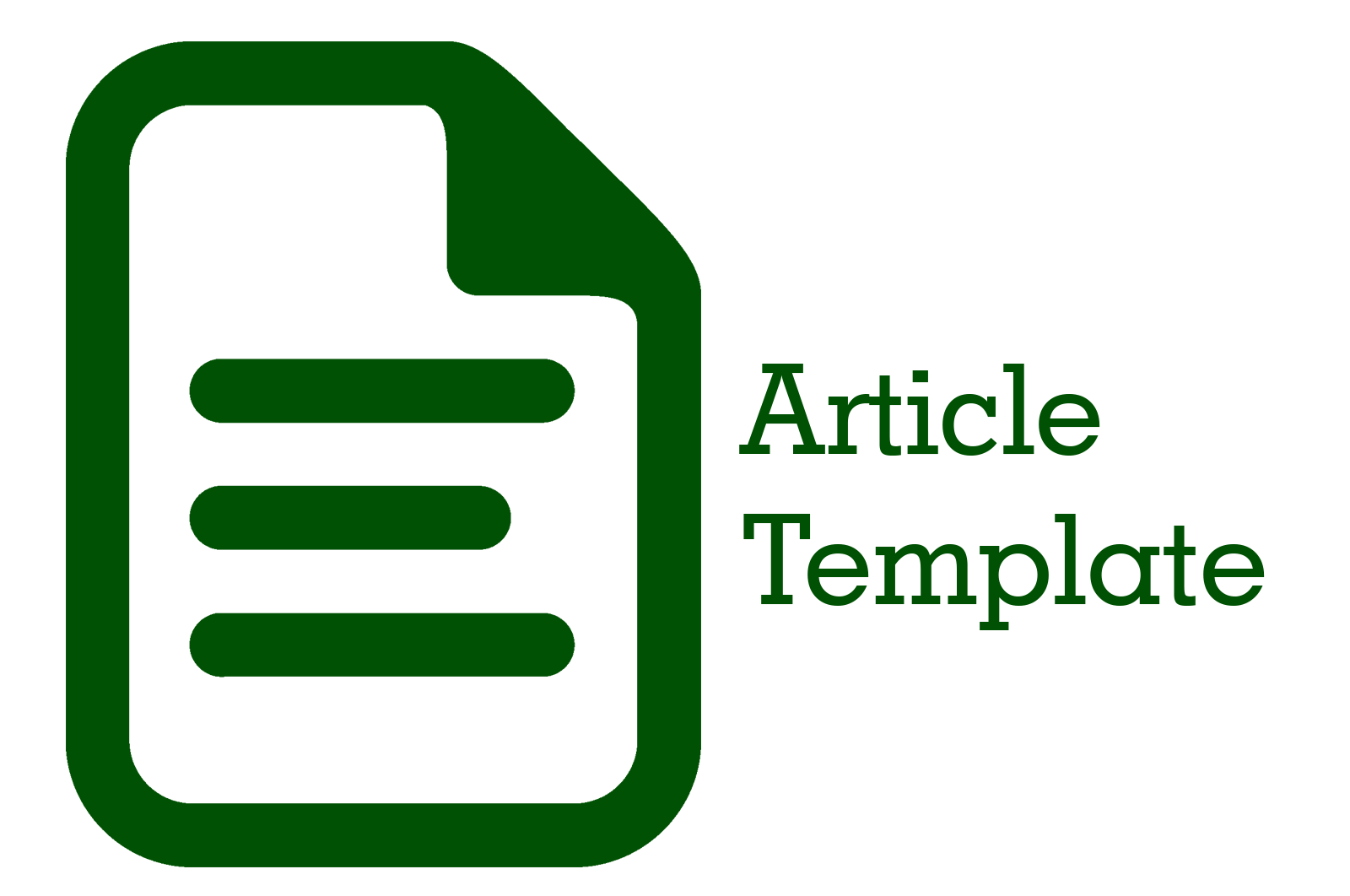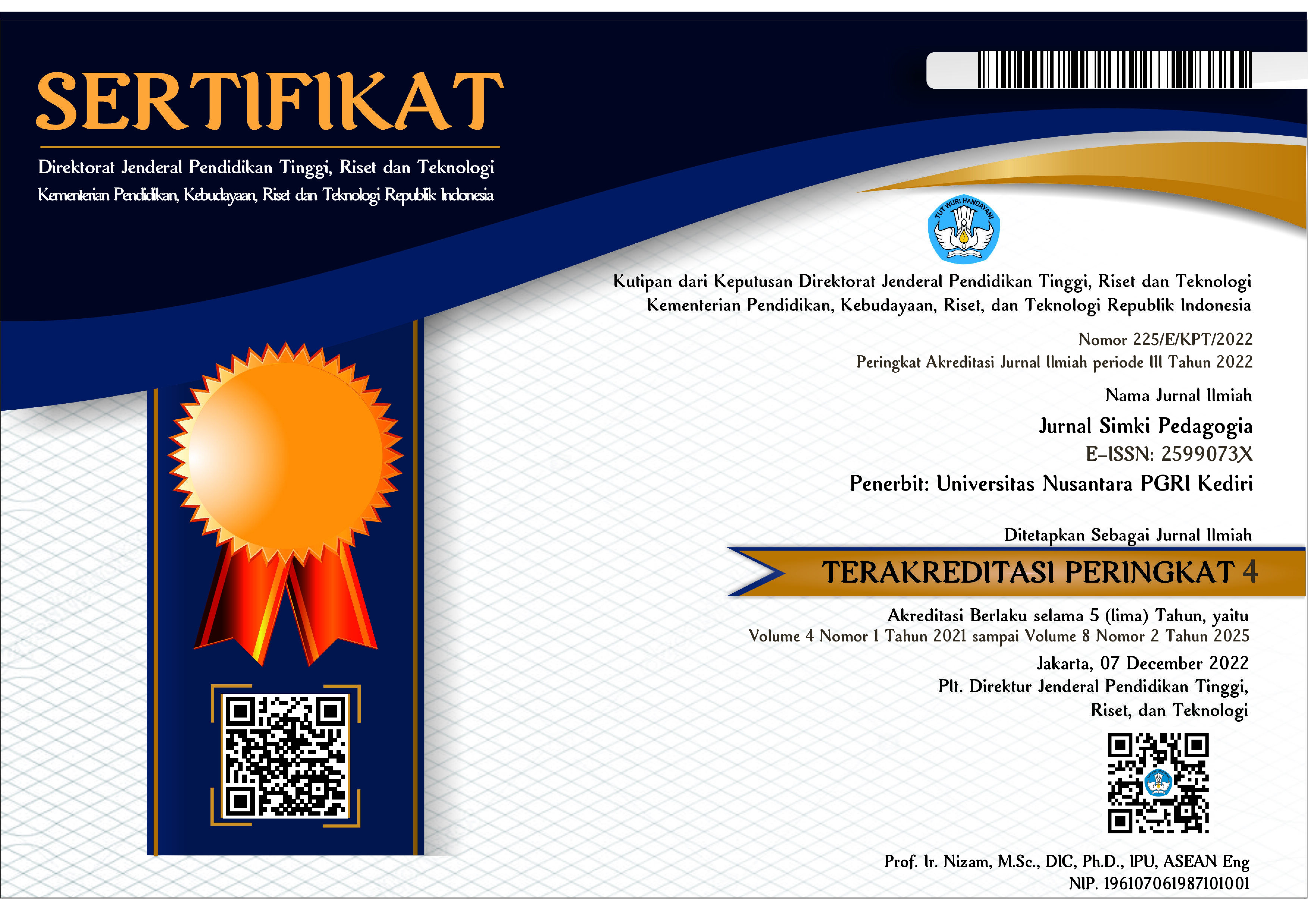Computational Thinking Assessment: Bibliometric Analysis-VOSviewer
 Abstract views: 328
,
Abstract views: 328
,
 PDF downloads: 269
PDF downloads: 269
Abstract
Computational thinking is a very important ability in the transitional era of the industrial revolution 4.0 to 5.0 because it has a role in supporting problem solving, especially in the field of Education by applying computer thinking. Seeing the role of computational thinking in education, an assessment is needed to assess students' ability to apply computational thinking to solve problems, especially in learning computer science. Therefore, the aim of this study is to present a high-quality bibliometric review of various literature on assessment computational thinking. This type of research is bibliometric analysis using VOSviewer. Literature was collected from the Scopus database of 191 articles published in 2019-2023. The results of this study show that in the network visualization results there are 5 clusters, namely cluster 1 (43 items), cluster 2 (31 items), cluster 3 (27 items), cluster 4 (21 items), and cluster 5 (19 items). Meanwhile, on the results of overlay visualization and density visualization, it can be seen that the computational thinking assessment research shows that when it is associated with the themes of instrument, validity, reliability, and computer science education, not much research has been done so that there are opportunities for renewable research by taking these themes.
Downloads
References
Abraham, I. (2022). Analisis bibliometrik vosviewer tentang centre of excellence lembaga diklat. Jurnal Pendidikan Dan Kewirausahaan, 10(1), 51–52.
Akhmad, N. A., Riskawati, Hamsyah, E. F., Gustina, Syarif, S. H., & Samsi, A. N. (2023). Edukasi computational thinking dalam proses pembejaran. Jurnal Pengabdian Kepada Masyarakat, 2(8), 5867–5874.
Ansori, M. (2020). Pemikiran Komputasi (Computational Thinking) dalam Pemecahan Masalah. Dirasah, 3(1), 111–126. https://doi.org/10.29062/dirasah.v3i1.83
Bilad, M. R. (2022). Bibliometric analysis for understanding the correlation between chemistry and special needs education using vosviewer indexed by google. ASEAN Journal of Community and Special Needs Education, 1(1), 61–68. https://ejournal.bumipublikasinusantara.id/index.php/ajcsne/article/view/61
Buchari, M. A., Arsalan, O., Firdaus, F., & ... (2019). Sosialisasi dan pelatihan bebras challenge untuk siswa SMP di Kota Palembang. Annual Research Seminar Computer Science and ICT, 5(2), 39–42. https://seminar.ilkom.unsri.ac.id/index.php/ars/article/download/2103/997
Chan, S.-W., Looi, C. K., & Sumintono, B. (2020). Assessing computational thinking abilities among Singapore secondary students: a Rasch model measurement analysis. Journal of Computers in Education. https://doi.org/10.1007/s40692-020-00177-2
Chevalier, M., Giang, C., Piatti, A., & Mondada, F. (2020). Fostering computational thinking through educational robotics: a model for creative computational problem solving. International Journal of STEM Education, 7(39). https://doi.org/10.1186/s40594-020-00238-z
Chong, B. (2019). Transforming the Quality of Workforce in the Textile and Apparel Industry through Digital Empowerment (Working Paper). The Educational Review, USA, 3(8), 96–105. https://doi.org/10.26855/er.2019.08.002
Dewantara, D., Sofianto, E. W. N., Misbah, & Munawaroh, D. (2021). Physics e-module: A review and bibliometric analysis. Journal of Physics: Conference Series, 2104(1). https://doi.org/10.1088/1742-6596/2104/1/012008
Diantary, V. A., & Akbar, B. (2022). Perbandingan keterampilan computational thinking antara sekolah dasar akreditasi a dengan sekolah dasar akreditasi b pada mata pelajaran matematika. Jurnal Cendekia: Jurnal Pendidikan Matematika, 6(3), 2749–2756. https://doi.org/10.31004/cendekia.v6i3.1576
El-Hamamsy, L., Zapata-Cáceres, M., Barroso, E. M., Mondada, F., Zufferey, J. D., & Bruno, B. (2022). The competent computational thinking test: Development and validation of an unplugged computational thinking test for upper primary cchool. Journal of Educational Computing Research, 60(7), 1818–1866. https://doi.org/10.1177/07356331221081753
Gillani, S. M. A. H., Senin, A. B. A., Bode, J., Muniba, & Gillani, S. M. A. H. (2022). Bibliometric analysis of digital entrepreneurial education and student intention: Reviewed and analyzed by VOSViewer from Google Scholar. International Journal of Interactive Mobile Technologies, 16(13), 48–65. https://doi.org/10.3991/ijim.v16i13.30619
Habibi, F., Fitriana, A., & Sulityowati, E. (2022). Pemetaan bibliometrik terhadap perkembangan penelitian e-Learning pada google scholar menggunakan vosviewer. Attractive: Innovative Education Journal, 4(2), 383–395.
Hanifah, S., Abdillah, T. D. F., & Wachyudi, K. (2022). Analisis bibliometrik dalam mencari research gap menggunakan aplikasi vosviewer dan aplikasi publish or perish. Journal of Innovation Research and Knowledge, 2(7), 2713–2728. https://bajangjournal.com/index.php/JIRK/article/view/4082
Haryandi, S., Suyidno, S., Misbah, M., Dewantara, D., Mahtari, S., & Ibrahim, M. A. (2021). Scientific creativity: A bibliometric review and analysis. Momentum: Physics Education Journal, 5(1), 10–20. https://doi.org/10.21067/mpej.v5i1.5002
Hossain, N. U. I., Dayarathna, V. L., Nagahi, M., & Jaradat, R. (2020). Systems thinking: A review and bibliometric analysis. Systems, 8(3), 1–26. https://doi.org/10.3390/systems8030023
Hufiah, A., Afandi, & Wahyuni, E. S. (2021). Analisis bibliometrik domain keterampilan berpikir tingkat tinggi dalam pendidikan abad 21 menggunakan vosviewer. Jurnal Sekolah, 6(1), 1–10. https://doi.org/10.24114/js.v6i1.29841
Indriyanti, F., Fauziah, T. N., & Nuryadin, A. (2023). Analisis bibliometrik penggunaan video pembelajaran di sekolah dasar tahun 2013-2022 menggunakan aplikasi vosviewer. Jurnal Educatio, 9(1), 23–31. https://doi.org/10.31949/educatio.v9i1.3906
Karim, A., Soebagyo, J., Nuranti, R. P., & Uljanah, A. L. (2022). Analisis bibliometrik menggunakan vosviewer terhadap trend riset matematika terapan di google scholar. Jurnal Riset Pendidikan Matematika Jakarta, 3(2), 23–33. https://doi.org/10.21009/jrpmj.v3i2.22264
Kılıç, S., Gökoğlu, S., & Öztürk, M. (2021). A valid and reliable scale for developing programming-oriented computational thinking. Journal of Educational Computing Research, 59(2), 257–286. https://doi.org/10.1177/0735633120964402
Korkmaz, Ö., & Bai, X. (2019). Adapting computational thinking scale (CTS) for Chinese high school students and their thinking scale skills level. Participatory Educational Research, 6(1), 10–26. https://doi.org/10.17275/per.19.2.6.1
Korkmaz, Ö., Çakir, R., & Özden, M. Y. (2017). A validity and reliability study of the computational thinking scales (CTS). Computers in Human Behavior, 72, 558–569. https://doi.org/10.1016/j.chb.2017.01.005
Lee, I., Grover, S., Martin, F., Pillai, S., & Malyn-Smith, J. (2020). Computational thinking from a disciplinary perspective: integrating computational thinking in K-12 science, technology, engineering, and mathematics Education. Journal of Science Education and Technology, 29, 1–8. https://doi.org/10.1007/s10956-019-09803-w
Lestari, D. R., Josephine, W., & Nuryadin, A. (2023). Analisis bibliometrik perkembangan pembelajaran online dengan aplikasi zoom menggunakan vosviewer. Jurnal Ilmu Pendidikan, 14(2), 194–204. http://jurnal.stkipkusumanegara.ac.id/index.php/jip/article/download/1586/1054
Lytle, N., Cateté, V., Boulden, D., Dong, Y., Houchins, J., Milliken, A., Isvik, A., Bounajim, D., Wiebe, E., & Barnes, T. (2019). Use, modify, create: Comparing computational thinking lesson progressions for STEM classes. Innovation and Technology in Computer Science Education, ITiCSE, 395–401. https://doi.org/10.1145/3304221.3319786
Maharani, A. (2020). Computational Thinking dalam Pembelajaran Matematika Menghadapi Era Society 5.0. Euclid, 7(2), 86–96. https://doi.org/10.33603/e.v7i2.3364
Mulyawati, I. B., & Ramadhan, D. F. (2021). Bibliometric and visualized analysis of scientific publications on geotechnics fields. ASEAN Journal of Science and Engineering Education, 1(1), 37–46. https://doi.org/10.3760/cma.j.cn121113-20210204-00128
Muntazhimah, Khansa, A., Yuliana, D., Rahmah, F., Putri, I. I. A., & Gani, R. (2022). Analisis bibliometrik terhadap kemampuan komunikasi matematis dan self-concept berbasis vosviewer. Jurnal Wahana Pendidikan, 9(2), 129–138. doi: http://dx.doi.org/10.25157/wa.v9i2.8171
Nguyen, H. D., Tran, K. P., Zeng, X., Koehl, L., Castagliola, P., & Bruniaux, P. (2019). Industrial internet of things, big data, and artificial intelligence in the smart factory: A survey and perspective. ISSAT International Conference on Data Science in Business, Finance and Industry, 72–76. https://hal.archives-ouvertes.fr/hal-02268119
Nurfaiziya, S., Munajat, E., & Nurasa, H. (2023). Study literature review ( SLR ) artikel kebijakan ketahanan air di database scopus dalam matriks analisis dan visulisasi vosviewer. Jurnal Ilmu Sosial Dan Pendidikan (JISIP), 7(1). https://doi.org/10.58258/jisip.v7i1.4471/http
Nurmahmudah, F., Yulianto, D., & Ilma Nafi’a, Z. (2020). Penerapan program literasi digital melalui computational thinking dalam pembelajaran. Seminar Nasional Hasil Pengabdian Kepada Masyarakat, 2(1), 327–338.
Ogegbo, A. A., & Ramnarain, U. (2022). A systematic review of computational thinking in science classrooms. Studies in Science Education, 58(2), 203–230. https://doi.org/10.1080/03057267.2021.1963580
Rodríguez-Martínez, J. A., González-Calero, J. A., & Sáez-López, J. M. (2019). Computational thinking and mathematics using scratch: an experiment with sixth-grade students. Interactive Learning Environments, 1–12. https://doi.org/10.1080/10494820.2019.1612448
Rosadi, M. E., Wagino, W., Alamsyah, N., Rasyidan, M., & Kurniawan, M. Y. (2020). Sosialisasi computational thinking untuk guru-guru di SDN Teluk dalam 3 Banjarmasin. Jurnal SOLMA, 9(1), 45–54. https://doi.org/10.29405/solma.v9i1.3352
Rosyda, M., & Azhari, A. (2020). Pelatihan computational thinking dan pembuatan game sederhana bagi guru SD Muhammadiyah se-Kecamatan Wirobrajan. Seminar Nasional Hasil Pengabdian Kepada Masyarakat, 339–348.
Rowe, E., Almeda, M. V., Asbell-Clarke, J., Scruggs, R., Baker, R., Bardar, E., & Gasca, S. (2021). Assessing implicit computational thinking in zoombinis puzzle gameplay. Computers in Human Behavior, 120, 106707. https://doi.org/10.1016/j.chb.2021.106707
Ruppert, T., Daranyi, A., Medvegy, T., Csereklei, D., & Abonyi, J. (2023). Demonstration laboratory of industry 4.0 retrofitting and operator 4.0 solutions: Education towards industry 5.0. Sensors, 23(283), 1–23. https://doi.org/https://doi.org/10.3390/ s23010283
Sarman, S. N., & Soebagyo, J. (2022). Analisis bibliometrik terhadap kemampuan berpikir kritis matematika berdasarkan pemecahan masalah berbasis vosviewer. Vygotsky: Jurnal Pendidikan Matematika Dan Matematika, 4(2), 117–128.
Satria, A. (2023). Analisis bibliometrik mengenai metode dakwah wali songo pada database dimensions. Gunung Djati Conference Series, 23, 664–671.
Schmidthaler, E., Schalk, M., Schmollmüller, M., Sabitzer, B., Andic, B., & Lavicza, Z. (2022). The effects of using poly-universe on computational thinking in biology and physical education. 14th International Conference on Education Technology and Computer (ICETC 2022). https://doi.org/10.1145/3572549.3572554
Supinah, R., & Soebagyo, J. (2022). Analisis bibliometrik terhadap tren penggunaan ICT pada pembelajaran matematika. JNPM (Jurnal Nasional Pendidikan Matematika), 6(2), 276–290. https://doi.org/10.33603/jnpm.v6i2.6153
Tamala, J. K., Maramag, E. I., Simeon, K. A., & Ignacio, J. J. (2022). A bibliometric analysis of sustainable oil and gas production research using VOSviewer. Cleaner Engineering and Technology, 7(100437). https://doi.org/10.1016/j.clet.2022.100437
Tang, X., Yin, Y., Lin, Q., Hadad, R., & Zhai, X. (2020). Assessing computational thinking: A systematic review of empirical studies. Computers and Education, 103798. https://doi.org/10.1016/j.compedu.2019.103798
Weintrop, D., Rutstein, D. W., Bienkowski, M., & McGee, S. (2021). Assessing computational thinking: an overview of the field. Computer Science Education, 31(2), 113–116. https://doi.org/10.1080/08993408.2021.1918380
Weng, X., & Wong, G. K. W. (2017). Integrating computational thinking into english dialogue learning through graphical programming tool. 2017 IEEE International Conference on Teaching, Assessment and Learning for Engineering (TALE). https://doi.org/10.1109/TALE.2017.8252356
Winata, I. G. A. S. P., Artayasa, I. N., & Wibawa, A. P. (2022). Penciptaan aplikasi permainan (game) sederhana berbasis computational thinking dengan memanfaatkan web scratch di SMPN 8 Denpasar. Jurnal Amarasi, 3(2), 152–158. https://jurnal2.isi-dps.ac.id/index.php/amarasi/article/download/1690/530
Yağcı, M. (2019). A valid and reliable tool for examining computational thinking skills. Education and Information Technologies, 24, 929–951. https://doi.org/10.1007/s10639-018-9801-8
Yasin, M. (2020). Computational thinking untuk pembelajaran dasar-dasar pemrograman komputer. Researchgate, 1–11.
Yin, Y., Hadad, R., Tang, X., & Lin, Q. (2020). Improving and assessing computational thinking in maker activities: the Integration with physics and engineering learning. Journal of Science Education and Technology, 29, 189–214. https://doi.org/10.1007/s10956-019-09794-8
Youjun, T., & Xiaomei, M. (2022). Computational thinking: a mediation tool and higher-order thinking for linking EFL grammar knowledge with competency. Thinking Skills and Creativity, 46(September), 101143. https://doi.org/10.1016/j.tsc.2022.101143
Zaharin, N. L., Sharif, S., & Mariappan, M. (2018). Computational thinking: a strategy for developing problem solving skills and higher order thinking skills (HOTS). International Journal of Academic Research in Business and Social Sciences, 8(10), 1265–1278. https://doi.org/10.6007/ijarbss/v8-i10/5297
Copyright (c) 2024 Reny Refitaningsih Peby Ria

This work is licensed under a Creative Commons Attribution 4.0 International License.

Jurnal Simki Pedagogia : https://jiped.org/index.php/JSP/index is licensed under a Creative Commons Attribution 4.0 International License.
















